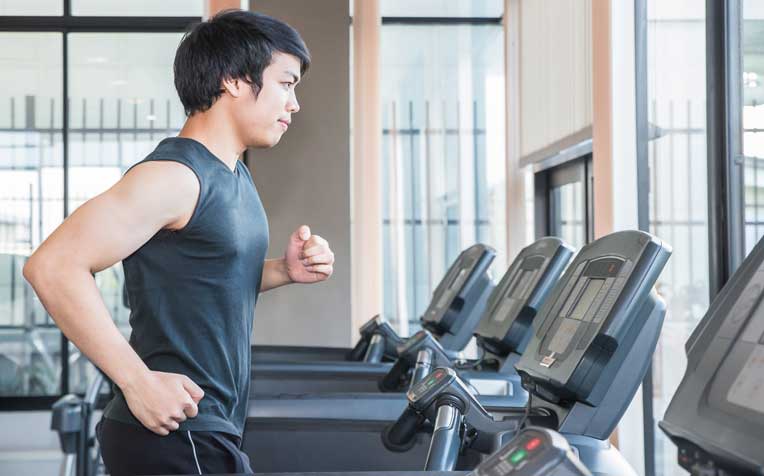
Cardiac rehabilitation includes running exercises on the treadmill.
If you have had a heart attack, cardiac rehabilitation is vital to prevent another attack.
Cardiac rehabilitation is a special programme offered by hospitals and heart centres. It enables, encourages and assists heart patients to recover from their heart condition and to maximise their potential of good cardiac health and function. It is a lifelong process and begins from the time of diagnosis.
The
National Heart Centre Singapore (NHCS), a member of the
SingHealth group, offers a structured cardiovascular rehabilitation and preventive cardiology programme that includes three main components:
Risk factor control and monitoring,
Patient education and
Individualised exercise training
The nurses and the physiotherapists will assess the patients and stratify them into low, moderate or high risk.
Clinical Associate Professor Tan Swee Yaw, Senior Consultant, Department of Cardiology and Director, Cardiovascular Rehabilitation and Preventive Cardiology, NHCS, says, “Generally, most patients after a heart bypass, valvular heart surgery, heart attack or balloon angioplasty should go for the cardiac rehabilitation programme. Each patient will be carefully evaluated to ensure that they are safe to undergo the programme.”
Importance of exercise for cardiac rehabilitation
Exercise intensity and exercise regimes are prescribed based on this stratification to allow patients to exercise at a safe maximum intensity that gives optimal benefit. The exercise sessions are supervised and monitored by the physiotherapists and nurses.
For the standard course, there are 16 sessions in total. During these sessions, patients undergo individualised cardiac rehabilitation using various exercise modalities which aim at improving their aerobic fitness as well as strength. Exercises include cycling, running on the treadmill and weight-lifting.
Check out these videos for simple 10-minute exercises to do at home.
Standing exercises
Sitting exercises
About NHCS cardiovascular rehabilitation and preventive cardiology programme
The NHCS cardiovascular rehabilitation and preventive cardiology programme started in 1996 with four patients. Since then, the programme has grown substantially, seeing about 500 new patients each year. However, Dr Tan said the number of participants is small compared to the total number of patients at NHCS.
As NHCS sees about 10,000 inpatients and over 100,000 outpatients every year, more patients should come and benefit from the programme.
Cardiac rehabilitation helps in the following ways:
Better control of the cardiac risk factors
Reduced mortality risk
Setting of the patient’s exercise target
Increased motivation to stay fit
Dr Tan said, “Ultimately, the programme aims to get patients back to their best functional capacity so that they can live life to their fullest.”
Participants are taught skills to continue their rehabilitation at home after they complete the programme.
How is success measured for cardiac rehab?
The programme’s success is linked to how well the cardiac risk factors are controlled. This includes tracking the patient’s blood pressure, glucose and cholesterol levels.
NHCS conducted a retrospective audit on 1445 patients who completed three months of cardiac rehabilitation between 1999 – 2004, measuring their blood pressure before and after the programme. While the entire cohort showed a modest 4 mmHg drop in systolic BP and diastolic BP drop of 1 mmHg, 182 patients who were identified as poorly controlled at the time of enrolment had significant decreases. Their systolic BP decreased 19.3 mmHg while diastolic BP dropped 12.7 mmHg. This effect was independent of medications as they did not have any alteration in pharmacotherapy during the three months they underwent cardiac rehabilitation.
“This change was statistically significant,” explained Dr Tan.
“It shows that cardiac rehabilitation can improve blood pressure control. Other studies have shown that cardiac rehabilitation can lead to a corresponding reduction in mortality risk of up to 25 per cent,” he added.
About NHCS cardiovascular rehabilitation and preventive cardiology programme
The NHCS cardiovascular rehabilitation and preventive cardiology programme started in 1996 with four patients. Since then, the programme has grown substantially, seeing about 500 new patients each year. However, Dr Tan says the number of participants is small compared to the total number of patients at NHCS.
As NHCS sees about 10,000 inpatients and over 100,000 outpatients every year, more patients should come and benefit from the programme, he said.
Ultimately, the programme aims to get patients back to their best functional capacity so that the patients can live life to their fullest.
Participants are also taught skills to continue their rehabilitation at home after they complete the programme.
Watch this video to learn more about the recovery journey!
Success stories of the cardiac rehabilitation programme
Dr Tan shared an anecdote of one of his patients, a man in his 50s who had an extremely poor heart function. The patient struggled with walking even short distances when Dr Tan first met him. The patient made good progress in the programme. When he was tested again after two years, he could actually run two kilometres.
“This is probably a combination of his own hard work and the medications he was prescribed,” Dr Tan said. “But it shows that in some patients, capacity can improve dramatically if all the factors are right. The right medication, the right exercise programme and the right risk factor control can really benefit patients.”
After graduating from the cardiac rehab programme, patients go on to other places to exercise. They even form groups with other patients and exercise together at a gym or a park. “One of the great things about the programme is that patients make a lot of friends. They help each other so that they are motivated to continue,” Dr Tan added.
Ref: H24 (ed)
Related article:
Contributed by














 Get it on Google Play
Get it on Google Play